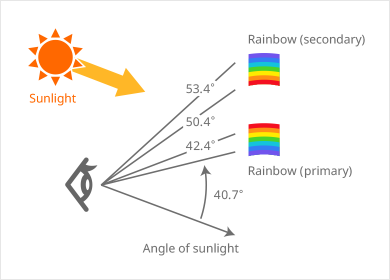A Discussion about Rainbows (2)

Right, so it has to be like this.
So let’s take a look at the problems with the rainbows in the dream.
- In a normal rainbow (primary rainbow), the red is at the outer edge and the violet is at the inner edge.
- When a rainbow is seen by an observer, it appears on the opposite side of the sky from the sun. So, the shadows of the trees should point/stretch toward the rainbow rather than to the right.
- In the same way, when seen by an observer, the circular axis of the rainbow should be precisely opposite the sun, so you can't have a rainbow on the right or left side directly in front of you.
- Similarly, rainbows cannot have their circular axes at two different places.
(However, rainbow-colored rings resulting from different principles than an ordinary rainbow can occur.)
Explanation of the Rainbow
After a rainfall, there will be a number of water droplets suitable in size for viewing a rainbow. When sunlight enters these water droplets, refraction, dispersion, and reflection occur within them. When you see the light coming out of these water droplets, it appears as a rainbow.

Fig. 1 Refraction and Reflection within a Water Droplet
Take a look at Fig. 1 Refraction and Reflection within a Water Droplet. When light enters water droplets, it is refracted because of the difference between the refractive index of air and water. The angle of refraction varies depending on the wavelength. Short wavelengths (violet) are bent relatively more in comparison to longer wavelengths (red).
Some of the light emerges from the water droplets whereas some is reflected and bounces around inside them.
The light that first comes out of water droplets in the opposite direction to the sunlight forms the basis of the rainbow (primary rainbow). The light emerging from a single water droplet is oriented at different angles depending on its wavelength, and when the light emerging from a number of water droplets enters your eye, it creates a rainbow.

Fig. 2 Red and Violet Light Emerging from a Water Droplet

Fig. 3 Angle Where Rainbows Are Visible
Let’s look again at the fact that the angle differs depending on the wavelength. Take a look at the image on the left in Fig. 2 Red and Violet Light Emerging from a Water Droplet. In the rainbow (primary rainbow) light emerging from a water droplet, the shorter wavelength (violet) is diffracted more in comparison to the longer wavelength (red). Accordingly, when looking from the left side of the figure (seen from the direction with your back to the sun), the light emerges at lower angles.
In Fig. 3 Angle Where Rainbows Are Visible, violet is seen at 40.7 degrees and red is seen at 42.4 degrees. (The angle will differ slightly depending on how the wavelength of the color is defined.) Therefore, rainbows appear with violet on the inner edge and red on the outer edge.
Even weaker light also emerges from the water droplets. This light is the basis for secondary rainbows (double rainbows). Take a look at the image on the right in Fig. 2 Red and Violet Light Emerging from a Water Droplet. If we consider the light in the image on the right when it reaches the eye, it will seem to be reversed vertically compared to the image on the left.
This is because the violet, which is diffracted more, appears at a relatively higher angle than the red. In Fig. 3, the red is at 50.4 degrees and the violet is at 53.4 degrees. (The angle will differ slightly depending on how the wavelength of the color is defined.)
Occasionally, a faint secondary rainbow appears outside the primary rainbow. Here, the order of red and violet are reversed in comparison to the sequence in the primary rainbow.
The inner edge of the primary rainbow will be bright due to the reflection from the water droplets, and the outer edge will be dark because there is no reflection. Also, the outer edge of the secondary rainbow will be bright and the inner edge will be dark. As a result, we see a dark band between the primary and secondary rainbows.

Primary, secondary, and supernumerary rainbows (Photo: Courtesy of the editorial staff at Shimadzu “Hot” Newsletter)
In addition, a faint excess rainbow (supernumerary rainbow) can be seen at the inner edge of the primary rainbow and the outer edge of the secondary rainbow. Also, in rainbows created by light reflected from the surface of water, the angle at which it is seen by the eye will change.
A variety of spectra can be seen in the natural world. These include halos formed in the vicinity of the sun, sun pillars, Brocken (the glory phenomenon), and aircraft shadow glory.
As the above demonstrates, the spectra resulting from the dispersion of light in nature are quite fascinating.


